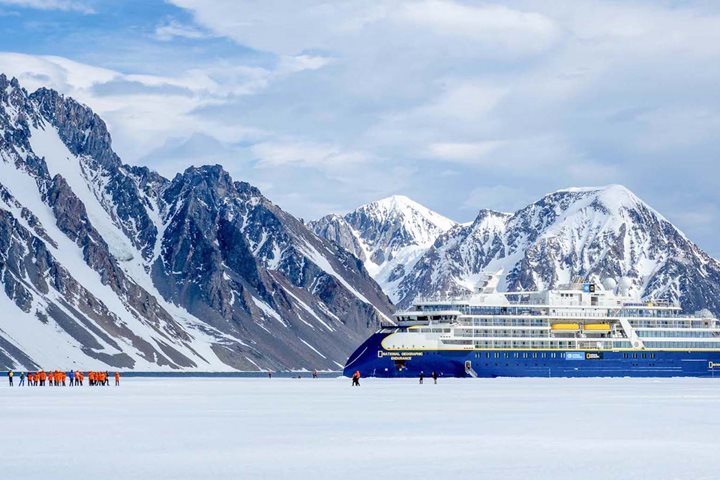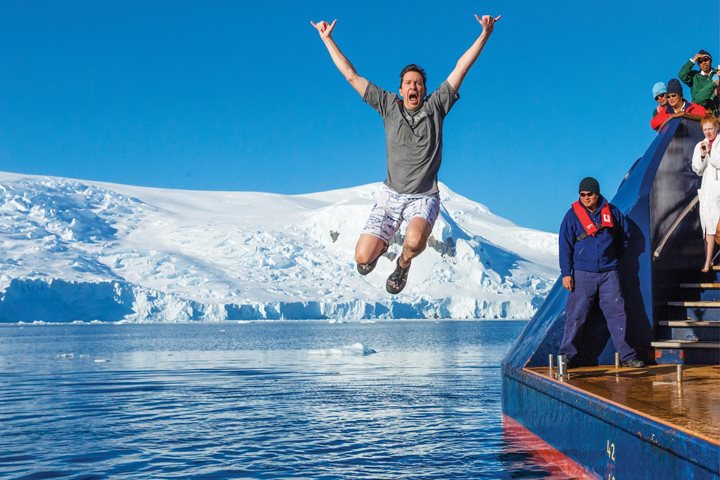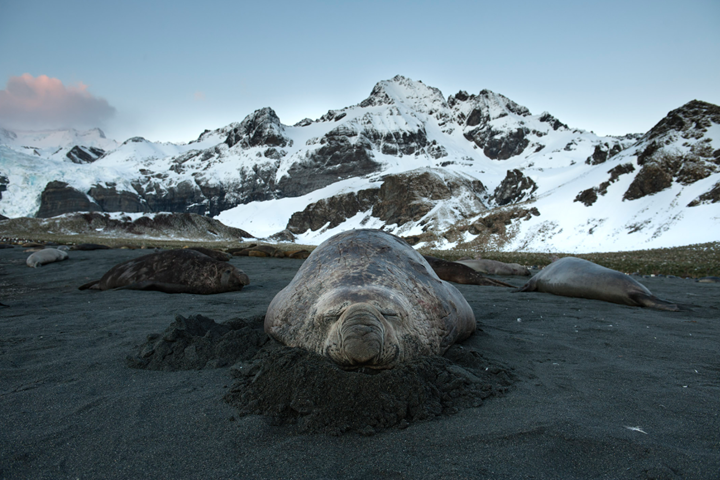Call +1.212.765.7740
- WorldView
- 6 Min Read
- 29 Jan 2019
How the Extreme Ice Survey Team Photographs South Georgia Island
“Difficulties are just things to overcome” –Sir Ernest Shackleton Get Inspired by Photos, Videos, Webinars, Stories, and Exclusive Offers. Sign Up
To those familiar with the trials and misfortunes met by explorer Sir Ernest Shackleton and the men of the Trans-Antarctic Imperial Expedition, this quote by “the Boss” will likely bring a brief chuckle, then perhaps a nod of respect or a contemplative stare filled with the thoughts of just how much credence those few words hold. Those less familiar with their difficulties may wish to read Endurance, by Alfred Lansing. It’s an exciting piece of Antarctic history at the very least.
We, the Earth Vision Trust/Extreme Ice Survey team, are gently rocking in the moderately turbulent seas off the southern tip of South Georgia Island — both the launching point and fateful end for Shackleton’s journey. We’ve just completed the 780 nautical mile crossing of the Scotia Sea, starting from Elephant Island on the far northeastern reaches of the Antarctic Peninsula and ending here — all in a little less than two days. In comparison, the same crossing took Shackleton and his team of five 17 days of suffering and a bit of dead-reckoning-luck to complete.
It’s late afternoon and long crepuscular rays of sunlight are breaking through the clouds hovering over sharp peaks that climb out of the sea directly in front of us. We’re on a scouting trip into the six mile-long Drygalski Fjord, a narrow slit that splits the southern end of the island nearly in half. Tomorrow we hope to install two cameras on Risting Glacier, sitting at the fjord’s head, but the strong katabatic winds ripping off the glacier, combined with the abundant sea spray, are certainly foreboding. We play around on the top deck of the ship, leaning into the wind, which is blowing hard enough to nearly support our weight — it feels as if we are flying. However, it’s not exactly the type of gusts in which we particularly care to install delicate electronics. The volatile weather of the sub-Antarctic climate looks to be putting an end to the sunny and comfortable installations we’ve experienced over the past two weeks. Thinking about the historical difficulties associated with this wild island, it can only be expected that things won’t come so easily.
South Georgia has been a hub for whaling, Antarctic exploration, and as of late, adventure tourism, but driving the purpose for our visit here are the island’s glaciers and wildlife. Glaciers pour off the Alaska-esque 9,000+ foot peaks that line the center of the island, which are met along the shores by thriving populations of fur seals, healthy colonies of king penguins, nesting albatross, bright green mosses, and gorgeous lichens. However, where the biodiversity is succeeding, the glaciers of South Georgia are struggling to maintain their presence in the warming climate.
The glaciers today pale in comparison to when Shackleton and his men traversed the island nearly 100 years ago. Take for example Bertrab Glacier at the stunning Gold Harbor. Images from Shackleton’s expedition show a robust glacier extending from high up, all the way down to the ocean. The glacier retained this appearance until the mid-1980s, when it began a dramatic retreat. It still provides a dramatic backdrop to the king penguins, but it’s barely the glacier it was 30 years ago. Since the 1950’s, the air temperature on South Georgia has warmed by nearly 3˚F. This is driving the vast majority of glaciers across the island to retreat, including the treacherous slopes that gave the rundown party of explorers endless grief. Our cameras will be there to watch, capturing these changes frame-by-frame, day-by-day.
Extreme Ice Survey cameras at Risting Glacier. Photo Courtesy of Extreme Ice Survey ©Earth Vision Trust
Turning back into Drygalski Fjord in the late afternoon of the next day, our hopes for calm winds are squashed by the telling whitecaps running down the fjord. The wind is steady at 40 knots. Captain Oliver turns the National Geographic Explorer sideways to the wind, providing a brief lull to load the Zodiac without getting completely drenched, a luxury that won’t last long.
Our eyes search the fjord wall for a relatively safe spot to install the cameras and we come to agree that a small rock perch about 200 feet up from the water and just over one mile from the terminus will work (it also happens to coincide with the terminus location as recently as 1993). Eric Guth, our newest honorary EIS team member and Lindblad Expeditions-National Geographic photo instructor extraordinaire, navigates a small kelp-filled bay and lands us ashore on a wind protected beach covered by a few dozen, ridiculously cute, fur seal pups.
After unloading the equipment, Dan and I heave the horribly unbalanced battery packs over our shoulders and sneak our way past a few sleeping seals and continue up the slippery slope to our install site. At this point I’d say our clothes are manageably wet, but now that we’re exposed to the full force of the wind and sideways rain, that quickly begins to change. The drilling begins, wires are tightened, and the housings go up as quickly as our wet and frozen fingers allow. The wind is making even small tasks incredibly difficult, but we manage to get two of the cameras running without too much rain soaking the housings. By now, our Gore-Tex outerwear appears as if we took a casual swim in the fjord. Just as the chill really starts to set in, we finish up and scramble back to our wind-protected beach.
The seals stare curiously as each of us instinctively break into silly dances and jumping jacks, perhaps interpreted as a celebration after installing cameras eight and nine, but in reality, a feeble attempt to warm our core until the Explorer returns for us in about an hour. A difficult installation no doubt, but the warmth and comfort of the Explorer quickly changes our fortune. We’re left thinking about the real hardships of the great explorers of the past, knowing we probably had that coming.



